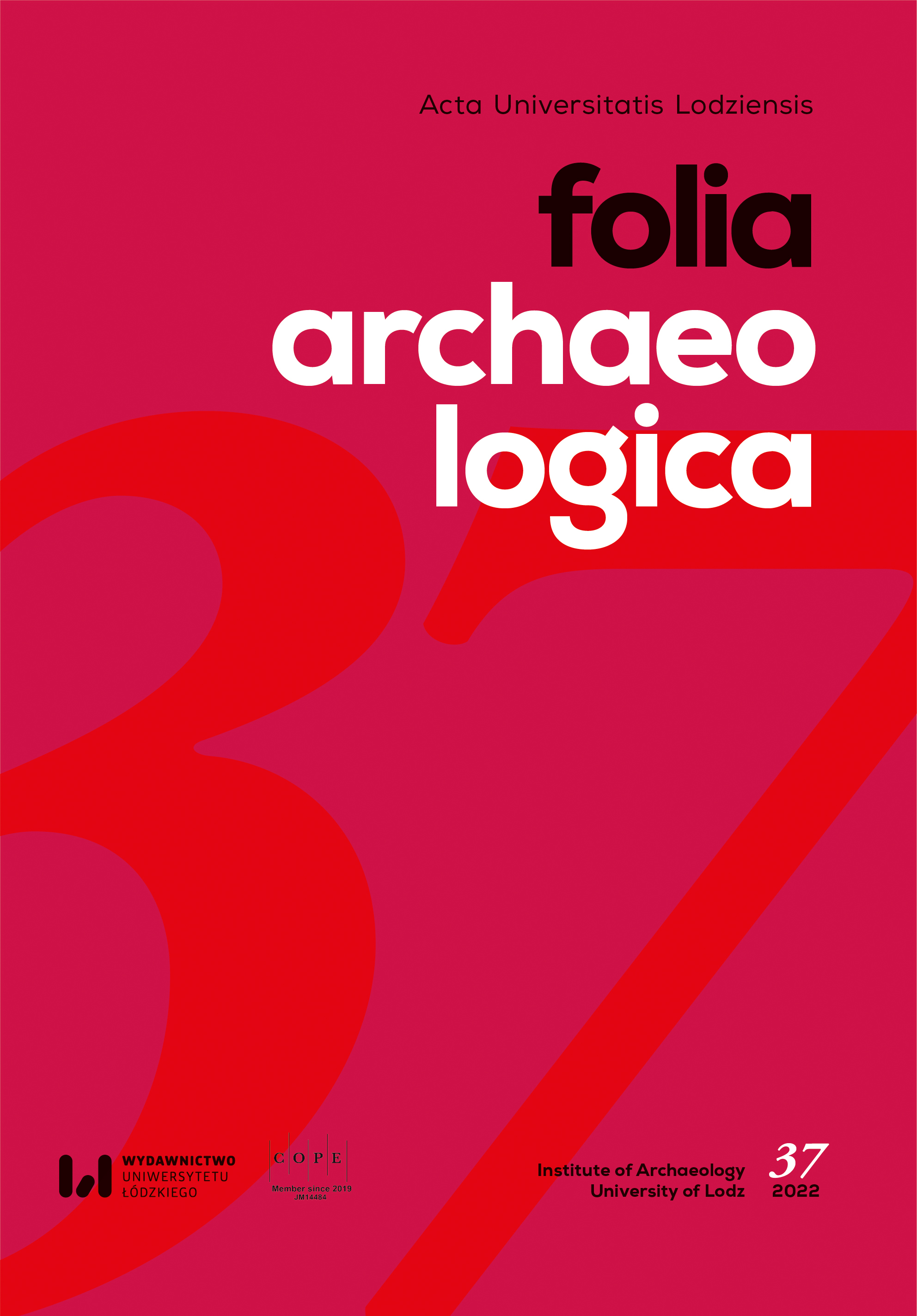The Relics of the Great War in the Foreground of the Dęblin Fortress as a Basis for the Creation of the Cultural Heritage of the Region
DOI:
https://doi.org/10.18778/0208-6034.37.06Keywords:
Dęblin fortress, the heritage of the Great War, Warsaw-Dęblin operation, the paradigm of preservation, the paradigm of heritage, archaeology of the contemporary pastAbstract
The article presents provisional results of research into material relics of the Great War in the foreground of the Dęblin Fortress. In the years 1914–1915, this area became the arena of battles between the Russian, German, and Austro-Hungarian armies. The hostilities left their mark on the landscape, such as field fortifications, forts, and cemeteries. The aim of the research was to locate and establish the chronology of the remains of field fortifications on the Gniewoszów-Bąkowiec-Mozolice line. The research involved analysis of source materials, LiDAR, field verifications, and analysis of the social value of relics of the Great War. The last phase of the research was analysis of the social value of these objects based on the philosophy of managing the past through preservation and heritage, exemplified by the cemetery in Wysokie Koło and the Gorchakov Fort. The research allowed to determine the course of the main Russian defence line from 1915, which consisted of three groups: Gniewoszów, Bąkowiec, and Mozolice. The best preserved are the remains of field fortifications within the Bąkowiec group, which was the central section of the Russian defence line. As analysis of the social value of the Great War relics indicates, the dominant way is to create heritage, and the message conveyed by the content of places representing the past causes a lot of controversy and conflicts among local residents.
Downloads
References
Abramczyk J. (1971), Partyzanci z kozienickiej puszczy. Wspomnienia dowódcy oddziału partyzanckiego BCH, Ludowa Spółdzielnia Wydawnicza, Łódź.
Google Scholar
Ashworth G. (2015), Planowanie dziedzictwa, Międzynarodowe Centrum Kultury, Kraków.
Google Scholar
Ashworth G., Tunbridge J. (1996), Dissonant Heritage. The Management of the Past as a Resource in Conflict, John Wiley & Sons, Chichester.
Google Scholar
Buczyński A., Gruszecki A. (1996), Cytadela Twierdzy Dęblin (Iwangorod), [in:] Fortyfikacja rosyjska na ziemiach polskich. Stan badań i problemy ochrony, vol. IV, TPF; “Zebra”, Warszawa–Kraków, p. 97–109.
Google Scholar
Bystrzycki A. (1976), Twierdza Dęblin (1837–1915), “Rocznik Mazowiecki”, 6, p. 171–204.
Google Scholar
Dąbkowski W. (1974), Powstanie styczniowe w Puszczy Kozienickiej, Państwowe Wydawnictwo Naukowe, Warszawa.
Google Scholar
Góral A. (2018), Zarzadzanie dziedzictwem – o paradoksie organizatorów przeszłości, [in:] Etnografie instytucji dziedzictwa kulturowego, Wydawnictwo Uniwersytetu Jagiellońskiego, Kraków, p. 177–188.
Google Scholar
Jaworski M. (1996), Takie Wysokie Koło, Towarzystwo Przyjaciół Górnictwa, Hutnictwa i Przemysłu Staropolskiego, Kielce.
Google Scholar
Kosiński D. (2016), 6. Pułk Legionów Polskich, “Przegląd Historyczno-Wojskowy”, 15.66, p. 7–27.
Google Scholar
Krahel S. (2003), Twierdza Boyen (Giżycko) – fortyfikacja jako atrakcja turystyczna, “Prace i Studia Geograficzne”, 32, p. 99–115.
Google Scholar
Michalski Ł. (1996), Forty twierdzy Dęblin (Iwangorod), [in:] Fortyfikacja rosyjska na ziemiach polskich. Stan badań i problemy ochrony, vol. IV, TPF; “Zebra”, Warszawa–Kraków, p. 109–129.
Google Scholar
Myga-Piątek U. (2005), Historia, metody i źródła badań krajobrazu kulturowego, “Problemy Ekologii Krajobrazu”, 17, p. 71–77.
Google Scholar
Myga-Piątek U. (2015), Pamięć krajobrazu – zapis dziejów w przestrzeni, “Studia Geohistorica”, 3.3, p. 31–47.
Google Scholar
Myga-Piątek U. (2018), Model stratygrafii krajobrazów kulturowych. W poszukiwaniu typologii ewolucyjno-genetycznej, “Prace Komisji Krajobrazu Kulturowego”, 39.1, p. 207–223.
Google Scholar
Opieka T. (2010), Twierdza śmierci. Stalag 307. Iwangorod–Irena–Dęblin 1939–1944, Towarzystwo Przyjaciół Dęblina, Dęblin.
Google Scholar
Rusnak M., Ramus E. (2019), Z okulografem w Muzeum Powstania Warszawskiego. Waloryzacja adaptacji historycznych, “Wiadomości Konserwatorskie. Journal of Heritage Conservation”, 58, p. 78–90.
Google Scholar
Rypulak A. (2014), Wielka Wojna 1914 roku pod Dęblinem, Wydawnictwo Nadwiślańskiego Stowarzyszenia Historii Militarne, Dęblin.
Google Scholar
Saunders N.S. (2003), Crucifix, Calvary, and Cross: Materiality and Spirituality in Great War Landscapes, “World Archaeology”, 35.1, p. 7–21, https://doi.org/10.1080/0043824032000078045
Google Scholar
DOI: https://doi.org/10.1080/0043824032000078045
Schwartz A.V. (1922), Oborona Ivangoroda v 1914–1915 g.g. : iz vospominaniy komendanta kreposti Ivangoroda, Moscow.
Google Scholar
Trzaskowski J. (2014), Fortyfikacje polowe na ziemi kozienickiej powstałe podczas Wielkiej Wojny 1914–1915, “Ziemia Kozienicka”, 29, p. 19–31.
Google Scholar
https://zabytek.pl/pl/obiekty/g235035/dokumenty/PL.1.9.ZIPOZ.NID_N_14_EN.329017/1 [28 IV 2022].
Google Scholar
Karta raspolozheniya voysk u Ivangoroda s 22 po 28 fevralya 1915 g. Available on: https://gwar.mil.ru/documents/view/id=118004770&backurl=document_name%5C%D0%98%D0%B2%D0%B0%D0%BD%D0%B3%D0%BE%D1%80%D0%BE%D0%B4::group%5Copisdoc:chasti:lk:mat:proch::types%5Cinstruction:alboms:maps_schemes:docs_english [28 IV 2022].
Google Scholar
Opisaniye boyevykh deystviy kreposti Ivangorod v techeniye avgusta, sentyabrya i oktyabrya 1914-gogoda). Available on: https://gwar.mil.ru/documents/view/?id=58578698&backurl=document_name%5C%D0%98%D0%B2%D0%B0%D0%BD%D0%B3%D0%BE%D1%80%D0%BE%D0%B4::group%5Copisdoc:chasti:lk:mat:proch::types%5Cdocuments:rlt_documents:book_area:prikazi_raspor:donesenie:reports_materials:svedenia: [28 IV 2022].
Google Scholar
Opisaniye boyevykh deystviy pod Ivangorodom (s 8-go iyulya po 22-ye iyulya 1915 goda). Available on: https://gwar.mil.ru/documents/view/?id=58590760&backurl=document_name%5C%D0%98%D0%B2%D0%B0%D0%BD%D0%B3%D0%BE%D1%80%D0%BE%D0%B4::group%5Copisdoc:chasti:lk:mat:proch::types%5Cdocuments:rlt_documents:book_area:prikazi_raspor:donesenie:reports_materials:svedenia [28 IV 2022].
Google Scholar
Vypiska iz zhurnala voyennykh deystviy kreposti Ivangorod). Available on: https://gwar.mil.ru/documents/view/?id=58578699&backurl=document_name%5C%D0%98%D0%B2%D0%B0%D0%BD%D0%B3%D0%BE%D1%80%D0%BE%D0%B4::group%5Copisdoc:chasti:lk:mat:proch::types%5Cdocuments:rlt_documents:book_area:prikazi_raspor:donesenie:reports_materials:svedenia: [28 IV 2022].
Google Scholar
Downloads
Published
How to Cite
Issue
Section
License

This work is licensed under a Creative Commons Attribution-NonCommercial-NoDerivatives 4.0 International License.












